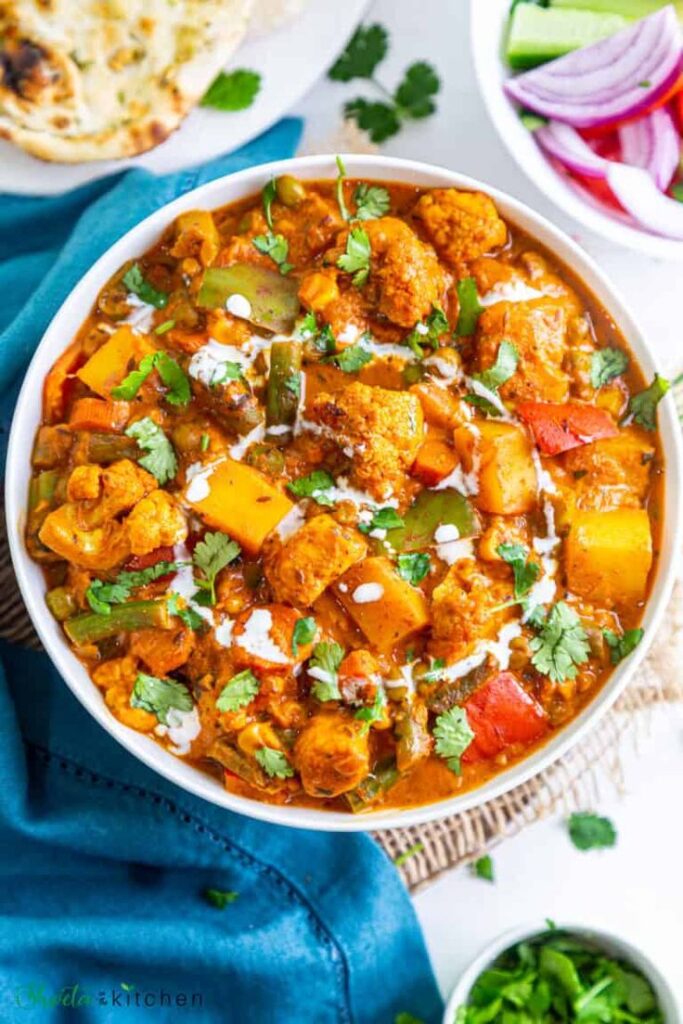
When it comes to Indian cuisine, few dishes match the vibrant and wholesome charm of Mixed Vegetable Curry. It’s a heartwarming medley of fresh, seasonal vegetables cooked in a rich, aromatic gravy. Whether you’re a health enthusiast or a food lover, this versatile dish deserves a place on your dining table.
In this blog, we’ll explore the essence of Mixed Vegetable Curry, its nutritional benefits, step-by-step preparation, and tips to make it extra special.
The Allure of Mixed Vegetable Curry
Mixed Vegetable Curry is a celebration of variety. It blends the goodness of vegetables like carrots, beans, peas, cauliflower, and potatoes with the richness of spices. The dish’s adaptability allows you to make it mild or spicy, creamy or tangy, depending on your palate.
Here’s why this curry is a standout:
- Nutritional Powerhouse: Packed with vitamins, minerals, and fiber from assorted veggies.
- Burst of Flavors: An interplay of spices, herbs, and fresh produce.
- Meal in a Bowl: Enjoy it with rice, naan, or chapati for a balanced meal.
Ingredients: A Treasure Trove of Goodness
Before we dive into the recipe, let’s gather everything you need for a classic Mixed Vegetable Curry. The beauty of this dish is its flexibility – use what’s available or what you love.
Essential Ingredients:
- Vegetables (2-3 cups, chopped): Carrots, beans, peas, potatoes, cauliflower, capsicum, etc.
- Onions: 2 medium, finely chopped.
- Tomatoes: 2 large, pureed.
- Ginger-Garlic Paste: 1 tablespoon.
- Green Chilies: 2, slit (adjust to taste).
- Coconut Milk or Cream: ½ cup (optional, for creaminess).
- Cilantro (Coriander Leaves): For garnish.
Spice Rack:
- Turmeric Powder: ½ teaspoon.
- Red Chili Powder: 1 teaspoon.
- Coriander Powder: 1 teaspoon.
- Cumin Powder: 1 teaspoon.
- Garam Masala: 1 teaspoon.
- Cumin Seeds: 1 teaspoon.
- Bay Leaf: 1.
For Cooking:
- Oil: 2 tablespoons (vegetable oil, ghee, or coconut oil).
- Water: 1-2 cups, as required.
Step-by-Step Guide to Make Mixed Vegetable Curry
Cooking Mixed Vegetable Curry is a delightful journey. Follow these steps for a perfectly balanced curry every time.
Step 1: Prepping the Vegetables
- Wash and chop the vegetables into bite-sized pieces.
- Steam or parboil hard vegetables like potatoes and carrots to speed up cooking.
Step 2: Sautéing Aromatics
- Heat oil in a large pan over medium heat.
- Add cumin seeds and a bay leaf; let them crackle.
- Toss in the chopped onions and sauté until golden brown.
- Stir in ginger-garlic paste and slit green chilies. Cook until fragrant.
Step 3: Building the Base
- Add the tomato puree and cook until the oil separates from the mixture.
- Season with turmeric, red chili powder, coriander powder, and cumin powder.
Step 4: Adding Vegetables
- Mix the prepped vegetables into the masala base.
- Stir well to coat them with the spices.
Step 5: Simmering the Curry
- Add water to achieve the desired consistency.
- Cover and let it simmer for 10-15 minutes, stirring occasionally.
Step 6: Finishing Touches
- Sprinkle garam masala and mix gently.
- For a creamy texture, stir in coconut milk or cream.
Step 7: Garnishing and Serving
- Garnish with fresh cilantro.
- Serve hot with steamed rice, roti, or paratha.
Tips to Elevate Your Mixed Vegetable Curry
- Experiment with Spices: Add fennel seeds or kasuri methi (dried fenugreek leaves) for a unique twist.
- Include Seasonal Veggies: Incorporate zucchini, bell peppers, or spinach for added freshness.
- Protein Boost: Add paneer cubes, tofu, or chickpeas for a heartier dish.
- Cook with Love: Allow the curry to simmer; slow cooking enhances flavor.
Nutritional Benefits of Mixed Vegetable Curry
Eating a variety of vegetables in one dish is not only delicious but also extremely healthy. Here’s what you get:
- Carrots: Rich in beta-carotene for healthy skin and eyes.
- Beans: High in fiber and low in calories, perfect for digestion.
- Peas: Loaded with antioxidants and a good source of plant-based protein.
- Potatoes: Provide energy with their natural starch content.
- Tomatoes: A powerhouse of Vitamin C and lycopene, good for immunity.
Why Choose Mixed Vegetable Curry for Your Meals?
This dish ticks all the boxes for a wholesome meal:
- Ease of Preparation: Minimal effort, maximum flavor.
- Crowd-Pleaser: Appeals to both vegetarians and non-vegetarians.
- Budget-Friendly: Utilizes inexpensive, easily available ingredients.
Pairing Suggestions: The Perfect Complements
While Mixed Vegetable Curry is delicious on its own, pairing it with the right side can elevate your meal:
- Rice: Jeera rice or plain steamed rice balances the rich gravy.
- Breads: Serve with buttery naan, soft chapati, or flaky paratha.
- Raita: A side of cucumber or boondi raita provides a cooling contrast.
Variations Across Regions
The versatility of Mixed Vegetable Curry has led to several regional adaptations in India. Here are some popular twists:
- South Indian Style: Includes coconut, curry leaves, and mustard seeds.
- North Indian Style: Creamy with cashew paste and yogurt.
- Gujarati Style: A slightly sweet version using jaggery and groundnuts.
A Dish for Every Occasion
Whether you’re hosting a festive dinner, prepping a weeknight meal, or looking to meal-prep for the week, Mixed Vegetable Curry is your go-to dish. Its versatility, health benefits, and deliciousness make it a winner.
Closing Thoughts: The Art of Cooking with Love
Cooking Mixed Vegetable Curry is more than following a recipe; it’s about infusing love and care into every step. Whether you’re an experienced chef or a beginner, this dish offers something new to learn and savor.

Pingback: Lauki Kofta: A Healthy Twist to a Classic Indian Delight